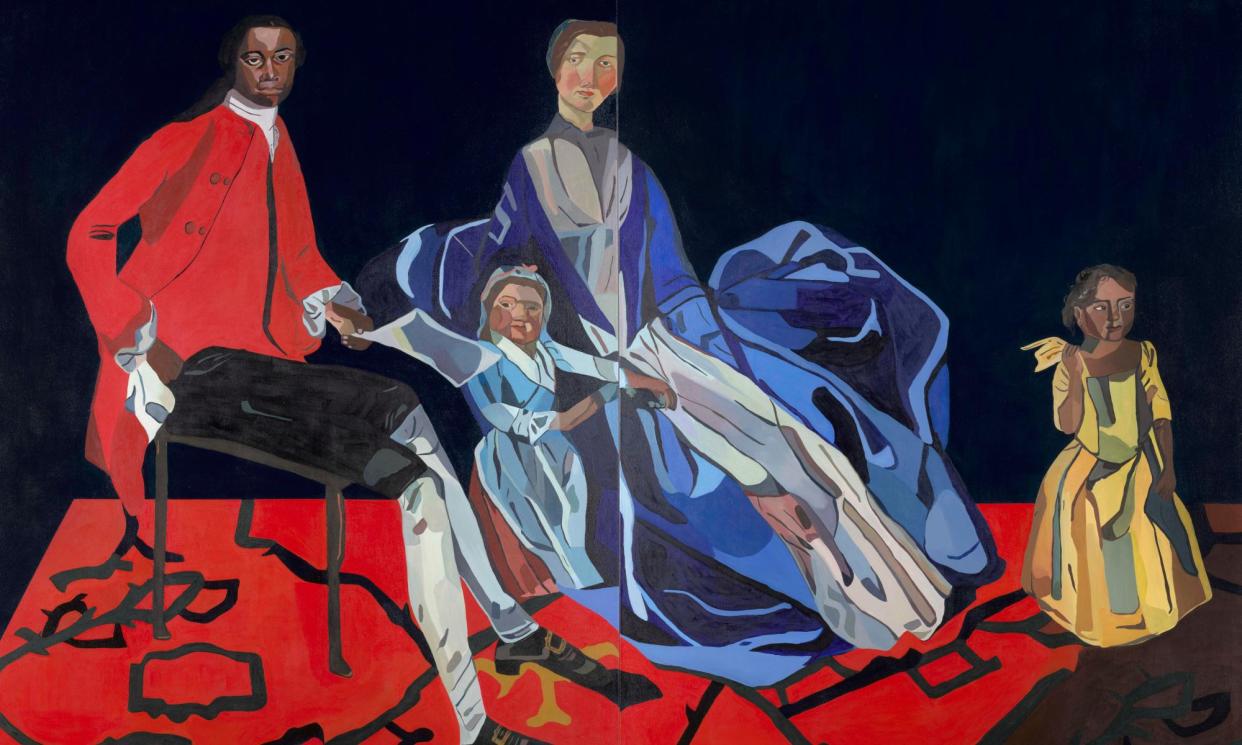‘Inclusivity shouldn’t be controversial’: will a radical art rehang give Cambridge an unwanted ‘woke’ row?

In a room called “identity”, 18th-century portraits by William Hogarth of a wealthy merchant family are going back on display. But now they will share space at the Fitzwilliam Museum in Cambridge with a subversive contemporary portrait by Black British artist Joy Labinjo, that imagines 18th-century African abolitionist Olaudah Equiano and his mixed-race family.
In another room, labelled “interiors”, Ethel Walker’s 1916 painting Silence of the Ravine – thought to be the earliest female nude painted by an openly lesbian artist in the UK – is waiting to be exhibited for the first time. Nearby, a wall of paintings dating from the 1720s to the 1920s all depict the same activity, once thought to be scandalous and unnatural: women reading.
When the university museum reopens its main painting galleries on 15 March after a major five-year refurbishment, its director, Luke Syson, is hoping that his radical shake-up of the way its world-renowned permanent collection is displayed will attract masses of visitors – but not masses of controversy.
“I would love to think that there’s a way of telling these larger, more inclusive histories that doesn’t feel as if it requires a pushback from those who try to suggest that any interest at all in work by women artists or artists of colour – or subject matter that takes us into the world of LBGT culture – is being ‘radical chic’ or what would now be called ‘woke’,” said Syson. “Being inclusive and representative shouldn’t be controversial; it should be enriching. We should all welcome the opportunities to understand each other better through the eyes of great makers and artists.”
Recent big rehangs of permanent collections, for example by the Tate and the National Portrait Gallery, were denounced by art critics as “preachy” and “fundamentally dull” attempts to tell people what to think, imposing “current concerns with slavery, empire, sexual identity and gender” on to famous art in a “glib”, “patronising”, and “belittling” way.
In the Fitzwilliam’s new display, which Syson said “suggests some new ways of looking, without insisting on them”, the museum’s much-loved, iconic works hang close to important “new discoveries” from its 208-year-old collection, by lesser-known painters, and major new acquisitions by eminent contemporary artists such as Labinjo, Barbara Walker and Jake Grewal.
Gone are the somewhat esoteric rooms filled with chronological displays of British and French masterpieces from the 18th, 19th and 20th centuries. Instead, each room has a simple theme, explained on an introductory panel. Paintings dating back to the 1600s from across Europe hang in the same room as contemporary works, to bring them into “thought-provoking dialogues” with each other, said the curator of the new rehang, Dr Rebecca Birrell.
“We want to continue to promote the creativity and strengths of our canonical artists, to celebrate their work and give it the space that it deserves. But we also want to put it back into dialogue with artists that have been previously under-represented in the museum,” she said.
She hopes the themes of the rehang – which also include “men looking at women”, “migration and movement” and “nature” – will illuminate dialogues between paintings across time and place, and highlight recurring motifs in art from different periods: “By grouping together very different-looking works that convey similar ideas, you can hear those conversations more clearly.”
In “men looking at women”, for example, the sensuous nude in Eugène Delacroix’s Odalisque (c1825) is contrasted with Dante Gabriel Rossetti’s virtuous Joan of Arc (1883) and an unsettling representation of women’s sexual power in Stanley Spencer’s Self-Portrait with Patricia Preece (1937).
Like Syson, Birrell is hoping the display will avoid the controversy of other rehangs: “Something I’ve been very conscious of, doing this particular rehang, is that youwant to provide the audience with stories without being overly didactic or determining the meaning of artworks. It’s just trying to provide possible readings, possible ways in, rather than definitive explanations,” she said. “You want the work to have the space to speak for itself.”
She is also aware that visitors may respond differently to the same display. “Part of the role of being a curator is creating opportunities for people to experience art on multiple different levels at once, and for your display to feel open to their response, but also to guide them towards ideas that might enrich that response,” she said.
Being aware that Rossetti’s Joan of Arc is a “kind of fantasy about femininity” won’t stop you from enjoying its beauty, she said. “I think it just gives you more to think about, and that people are capable of having more complex thoughts about art than just simply ‘it’s beautiful’.”
Syson thinks the Fitzwilliam Museum, which was founded by the University of Cambridge in 1816 from an endowment of shares in the slave-trading South Sea Company, has a responsibility to create a place for debate and discussion about the legacies of history, and to “think harder” about who comes to art galleries and how art can challenge prejudices. “Unless we understand our histories, and the images that embody them, we can’t hope to repair some of the damage that those legacies caused. We cannot set up new relationships that take us in new directions.”
For Birrell, it is a question of historiography – “who was writing the history books – especially in terms of women artists. Not representing them in museums gives an inaccurate image of history. They belong in dialogue with these more famous canonical artists in our collection because they always were in dialogue with them when they were alive.”


